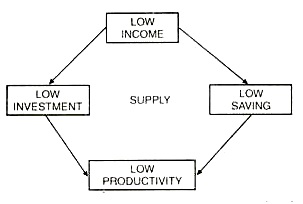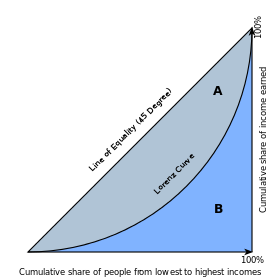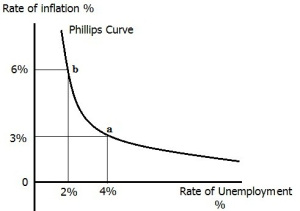वापस जायें / Back
Poverty and Unemployment in India
Poverty
Poverty line – It is income at such low level that a person is not able to fulfil his physical needs. Poverty line is different in different countries. For example poverty line in USA is much higher than poverty line in India
Poverty line according to World Bank – World Bank has kept poverty line at '2 per capita per day for developed countries and '1.25 per capita per day for underdeveloped or developing countries.
Poverty line according to Planning Commission Task Force – Task force of the Planning Commission had defined poverty line on the basis of nutrition as money required to provide at least 2100 calories in urban areas and 2400 calories in rural areas.
Poverty according to Lakdawala Committee – In the year 1989 planning commission appointed another task force under D.T. Lakdawala. This task force made separate poverty lines for each state. The poverty line made by them was based on Consumer Price Index (CPI) for Industrial Labor in urban areas and on Consumer Price Index for Agricultural Labor in rural areas.
In the year 1990 once again calories were made the basis of poverty line.
Suresh Tendulkar Committee – This committee proposed per capita consumer expenditure instead of calories as the basis of calculating poverty. The committee kept Rs 1000 per capita per month (Rs 33 per day) in urban areas and Rs 816 per capita per month (Rs 27 per day) in rural areas.
Dr. C. Rangrajan Committee – This committee constituted by the planning commission in 2012 kept urban poverty line at consumption expenditure less than Rs 1407 per capita per month (Rs 47 per day) and rural poverty line at Rs 972 per capita per month (Rs 32 per day). According to this committee the number of poor in 2011-12 in India was 29.5%. The Sates with the larges proportion of poor people were – Chhattisgarh – 47.9%, Manipur- 46.7% and Odisha – 45.9%.
The proportion of poor was least in Goa. The largest absolute number of poor people is in Uttar Pradesh and after that in Bihar.
National Sample Survey Organisation (NSSO) used Uniform Reference Period (URP) of 30 days recall for expenditure on all goods and Mixed Reference Period (MRP) of 365 days for expenditure on 5 non food items including cloths, shoes, durables, health and education for survey of poverty–
According to this survey poverty in India was as follows -
| Survey Year | India | Rural | Urban |
| 2004-2005 | 37.2% | 42% | 25.5% |
| 2009-2010 | 29.8% | 33.8% | 20.9% |
| 2011-2012 | 21.95 | 25.7% | 13.7% |
Important Concepts
Vicious circle of Poverty – Regner Nurksey has said that the main reason of poverty is lack of capital formation. There are low savings due to poverty which lead to low investment. Low investment causes low productivity which increases poverty. This is called vicious circle of poverty.

Lorenz Curve
This is a graph to measure inequality in a country. Percentage of households is plotted on the X-axis and percentage of the share of income on the Y-axis.

Gini Coefficient – Gini Coefficient is based on Lorenz curve and is a measure of income and wealth inequality in a society. If the Gini coefficient is 0 then all the income of all persons in the society is equal. On the other hand if it is 1 then it means that all income is concentrated in a few hands.
Poverty Ration – The proportion of population below the poverty line is called poverty ratio.
Poverty trap – When the person who is getting social security money from the Government in schemes like widow pension, social security pension, unemployment allowance etc. stops searching for employment because the income which he may get from employment is less than what he gets in from social security he is said to have fallen in poverty trap.
Phillips Curve -The Phillips curve is an economic concept developed by A. W. Phillips showing that inflation and unemployment have a stable and inverse relationship. The theory states that with economic growth comes inflation, which in turn should lead to more jobs and less unemployment. However, the original concept has been somewhat disproven empirically due to the occurrence of stagflation in the 1970s, when there were high levels of both inflation and unemployment.

Main reasons of poverty in India – Lack of education, unemployment, ill-health, population pressure, low development levels, inflation, inadequate capital, lack of skills, non-availability of high technology, lack of infrastructure etc.
Effects of Poverty – Illiteracy, malnutrition, ill-health, child labour, social tensions, housing problem (people live on the footpath and on the roadside and other open spaces), gender discrimination, increase in crime rate, social and political friction, etc.
Methods of Poverty Reduction – Spread of education, better health case, population control, creation of employment opportunities, control on inflation, use of high technology, Development of agriculture sector, special poverty elimination programme, efforts to provide for minimum needs of the poor, special attention to the deprived classes, etc.
World Bank Report on Poverty 2015 – The title of the report is – “Ending Extreme Poverty and Sharing Prosperity”. The old scale of poverty measurement of '1.25 per capita per day was changed to '1.9 per capita per day (PPP). 9.6% of the world population (70.2 crores) is poor. In India 12.4% population is poor which is the highest in the world. The aim is poverty elimination by the year 2030.
Unemployment
The problem of unemployment is found both in developed and developing countries. John Maynard Keynes considered this to be the biggest problem of any country. He used to say that if a country does not have enough work fo the unemployed their labor should be used to dig and fill ditches. Bu doing to even if they are not engaged in productive work at least they will not be doing unproductive things and the demand for goods and services in the country will be maintained.
Definition of unemployment -
A person who is willing to work at the prevailing market wage but is not able to get work is called unemployed person.
The definition of employment varies from country to country, e.g. in the USA if a person is not able to get a job according to his qualifications, he is considered unemployed.
The unemployment found in developing countries is of the following types -
- Seasonal Unemployment: Seasonal unemployment occurs when people are unemployed at particular times of the year when demand for labor is lower than usual. This kind of unemployment is found typically in agriculture sector during non-agriculture season.
- Disguised Unemployment (Disguised Unemployment): It exists where part of the labor force is either left without work or is working in a redundant manner where worker productivity is essentially zero. It is unemployment that does not affect aggregate output. For example if 10 persons make 100 shoes in a factory but is 3 are removed and still 100 shoes are made, then these 3 people so removed will be called disguised unemployed. In India this is a big problem in agriculture sector.
- Structural Unemployment: Structural unemployment refers to a mismatch between the jobs available and the skill levels of the unemployed. Unlike cyclical unemployment, it's caused by forces other than the business cycle. It occurs when an underlying shift in the economy makes it difficult for some groups to find jobs. For example in India everyone has a mobile phone now so people who were engaged in the PCO business became unemployed.
The following two types of unemployment is found in developed countries –
- Cyclical Unemployment: Cyclical unemployment is a factor of overall unemployment that relates to the cyclical trends in growth and production that occur within the business cycle. When business cycles are at their peak, cyclical unemployment will be low because total economic output is being maximized.
- Frictional Unemployment: Frictional unemployment is when workers leave their jobs to find better ones. It's usually a voluntary exit but can also result from a layoff or termination with cause. Friction is the time, effort, and expense it takes the worker to find a new job. Friction is unavoidable.
Other forms of unemployment are-
- Voluntary Unemployment: A voluntarily unemployed person is one who rejects a position while looking for one with better pay or benefits. Most frictional unemployment (unemployment when one is between jobs) is considered voluntary because one is looking for work rather than taking any job one finds.
- Open or Involuntary Unemployment: Involuntary unemployment occurs when a person is willing to work at the prevailing wage yet is unemployed.
- Low employment:In this people do not get work according to their ability and work for shorter durations.
- Technological unemployment: The term technological unemployment is used to describe the loss of jobs due to advances in automation and other technologies. Technological unemployment is a form of structural unemployment, which is a permanent shift in the availability of certain jobs.
- Educated unemployment: When people do not get jobs according to their education levels.
Measurement of Unemployment – Measurement of unemployment in India is done by NSSO. Three methods are used of this –
- Usual Principal Status (UPS) or Usual Status (PS) - The status of activity on which a person has spent relatively longer time of the preceding 365 days prior to the date of survey is considered to be the usual principal activity status of the person. If an individual was ‘working’ and/or was ‘seeking or available for work’ for major part of the year preceding the date of survey then h/she is considered as being part of the 'Labor Force' If he was seeking work for the most part of the preceding 365 days and was not working he will be considered unemployed.
- The Current Weekly Status (CWS) approach to measuring unemployment uses seven days preceding the date of survey as the reference period. A person is considered to be employed if he or she pursues any one or more of the gainful activities for at least one-hour on any day of the reference week. On the other hand, if a person does not pursue any gainful activity, but has been seeking or available for work, the person is considered as unemployed.
- The current daily status approach to measuring unemployment seeks to ascertain the activity status of an individual for each day of the reference week. It reports time disposition of an individual on each day of the reference week. This means that in addition to recording the activity being pursued, time intensity is also recorded in quantitative terms for each day of the reference week. If a person is engaged in economic activities for 4 hours he is considered employed for half day and if for more tan 4 hours then full day.
According to the survey done by the Labour Ministry in 2011-12 the unemployment rate in India is 3.8%. Among the states unemployment rate is the least in Gujarat at 1% and high in Delhi and Maharashtra at 4.8% and 2.6% respectively. The States with highest unemployment rate were Kerala and West Bengal. Unemployment rate among women was 7%.
Unemployment Rate – The number of unemployed persons multiplied by 100 and divided by the total labour force.?
As per the latest World Employment and Social Outlook report of the International Labor Organization (ILO) it is estimated that unemployment rate in India will increase by 3.5% from 2017 to 2018.Earliet it was expected to be 3.4%.
Indian Context
- The number of unemployed is likely to be 18.3 Million instead of 17.8.
- In terms of percentage the unemployment rate in India is expected to be stable at 3.5% through 2017, 2018 and 2019.
- 23 million new jobs will be created in Asia Pacific regions and new jobs will also be created in India and other south Asian Countries but the number of unemployed in the entire region will also increase.